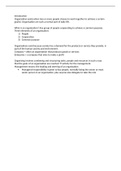Introduction
Organisation exists when two or more people choose to work together to achieve a certain
goal(s). Organisation are such a normal part of daily life.
What is an organisation? Any group of people cooperating to achieve a common purpose.
Three elements of an organisation:
1) People
2) Cooperation
3) Common purpose
Organisations exist because society has a demand for the products or service they provide. Is
part of the human society and environment.
Company = often an organisation that produces goods or services
Enterprise = a company that aims to make a profit
Organising involves combining and structuring tasks, people and resources in such a way
that the goals of an organisation are reached activity for the management.
Management means: the leading and steering of an organisation
Managerial responsibility is given to key people, normally being the owner or most
senior person in an organisation, plus anyone else delegate to take the role
,Hoofdstuk 0 – introduction
0.1 introduction
Organisational behaviour can be defined as ‘an interdisciplinary science concerned with the
study of the behaviour of organisations, as well as with the factors that determine this
behaviour and the manner in which organisations can be directed with maximum
effectiveness. two aspects:
1) A descriptive aspect: a description of the behaviour of organisations, including
motives and consequences
2) A prescriptive aspect: this is advice about recommended organisational design and
course of action
0.4 schools of thought and personalities
Figuur 0.1
Form Neo Human only Likert and Maslow
0.6 Frederick taylor and scientific management (ca. 1900)
Taylor: managers need a broader view of their tasks within the organisation: planning,
coordinating, overseeing and verifying results.
- key elements
Scientific analysis of the activities, time and motion studies to be used
Extensive division of labour and workforce training
Close and friendly working relationships between managers and workers
Managers are held responsible for seeking and analysing appropriate working
methods and for creating optimum conditons for production
Best man on the job
Financial rewarding for adhering, to reduce production costs
- eight bosses system: each area to be sole responsibility of a particular individual:
Time and costing, Task instructions, Processes and their order, work preparation,
maintenance, quality control, technical guidance, personnel management
The increase in efficiency was rarely match by the increase in wages or improvement
Improvement in management using similar methodes
0.7 Henri Fayol and general management-theory
Fayol: looked at production angle. Each employee should report to one immediate superior.
Six independent management activities
- Technical
- Commercial
- Financial
- Security
- Accounting
- Direction
Direction comprises the mainstay of the functions of managers (tasks):
1) planning or anticipating: setting up action for the future
2) organising: structuring the organisation using people and resources
3) commanding: ensuring full employee participation
4) coordinating: aligning each activity to the plan
, 5) controlling: ensuring that the results conform to the planning
Taylor’s functional on manufacturing companies + Fayol on management in general
0.8 Max weber and bureaucracy theory (ca. 1920)
Bureaucracy: tasks division, hierachial structure, responsibility, relationships, promotion,
data control, the power of officals, ability and knowledge, laid down procedures
Weber: bureaucracy was the most effienct form of organisation. Perfect means for reaching
management target and raise goal
0.9 Elton mayo and the human relations movement (ca. 1945)
Elton Mayo: searching between the connection improvement in working conditions and
productivity. Also objective factors and subjective factors have an effect on results.
Group feeling was the most important factor new management based on the social needs
of workers in small groups. Cooperation, (proper social skills) very important. The link
between human factor and organisational effectiveness most significant contribution
The Human relation movement: highly rationalistic approach to working organisations
0.10 Rensis Likert (and others) add the neo-human relations approach (c 1950)
- The human relations movement criticism overly idealistic view of organisations, kind of
social club, but don’t exist in practice.
- Neo-human relation: Warren G. Bennis relation between scientific management (an
organisation without men) and human relation movement (group men without
organisation).
- Likert: reconcile the two movements. Look at the organisational structure and
communication liking pin model: the organisation consisting of a number of overlapping
groups, whose leaders are also member of a higher group.
- Maslow: five levels of human needs. Hierarchy presented as a pyramid.
1) physiological needs
2) security and safety needs
3) love or relationship needs
4) recognition needs
5) self-actualisation needs
- theorie Douglas McGegor: theory X and Y
theory X: how most organisations worked at the time (scientific management)
Theory Y: own vision of how people in organisation should cooperate.
0.12 Paul Lawerence and Jay Lorsch and the contingency approach
Practical effectiveness of the organisational behaviour theories by Taylor and Fayol. No
connection between extent of the enterprise according to the rules of scientific
management.
Paul Lawrence + Jay Lorsch contingency theory: the choice of management technique
deriving form a theory of organisational behaviour is strongly influenced by the
circumstances in which an organisation finds itself
- Elements: relationship between an organisation and it surroundings
,






